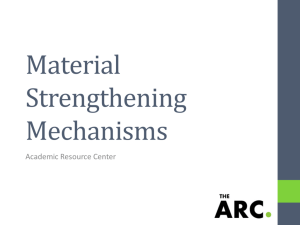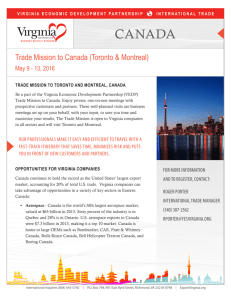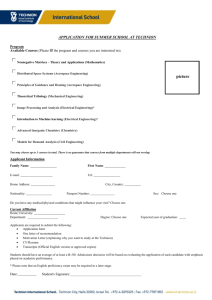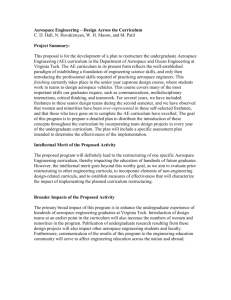10 - Work hardening & annealing
advertisement
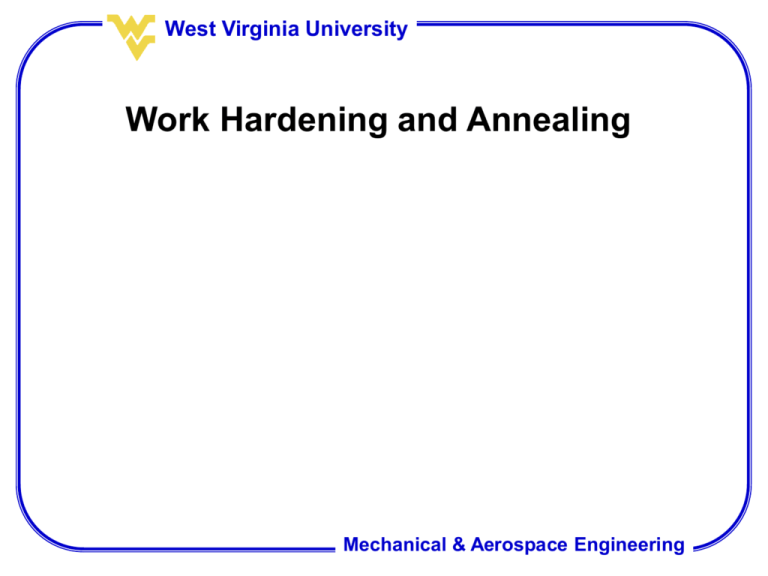
West Virginia University Work Hardening and Annealing Mechanical & Aerospace Engineering West Virginia University Principal of Strengthening The ability of a metal to plastically deform depends on the ability of dislocation to move. Restricting or hindering dislocation motion renders a material harder and stronger Mechanical & Aerospace Engineering West Virginia University Metal Working Methods • Change in cross-sectional area • %CW = (A0 – A)/A0 x 100 Rolling Forging A Ao Ao A Extrusion Drawing A Ao Ao Mechanical & Aerospace Engineering A West Virginia University Strain (Work) Hardening Mechanical & Aerospace Engineering West Virginia University Tensile Test – Work Hardening * n is the strain-hardening exponent K is the strength coefficient Mechanical & Aerospace Engineering West Virginia University Tensile Test – Work Hardening log-log curve of vs. - Slope of the curve is n Various hardening components - Lower n means poor respond to work hardening Mechanical & Aerospace Engineering West Virginia University Values for n and K for metals at room temperature Metal Condition n K, psi 0,05% C steel Annealed 0,26 77000 SAE 4340 steel Annealed 0,15 93000 0,60% C steel Quenched and tempered 1000oF 0,10 228000 0,60% C steel Quenched and tempered 1300oF 0,19 178000 Copper Annealed 0,54 46400 70/30 brass Annealed 0,49 130000 Mechanical & Aerospace Engineering West Virginia University Strain (Work) Hardening Cold work will lead to: •Increase of Yielding Strength •Increase of Tensile Strength •Reduction of Elongation Material becomes stronger but more brittle Effect of cold work on mechanical properties of Cu-1.5Ti alloy S. NAGARJUNA, K. BALASUBRAMANIAN, 1997 Mechanical & Aerospace Engineering West Virginia University Strain (Work) Hardening Mechanical & Aerospace Engineering West Virginia University Strain (Work) Hardening Reason: Increasing dislocation density and the interaction between dislocations, which reduces dislocation mobility. As a result, larger stresses must be applied in order that additional deformation may taken place. Dislocation Multiplication: - Before deformation a metal contains about 106 cm of dislocation line per cubic centimeter of metal. The number of dislocations may increase to 1012 cm of dislocation line per cubic centimeter of metal. Mechanical & Aerospace Engineering West Virginia University Strain (Work) Hardening – Dislocation Multiplication Frank-Read Source Mechanical & Aerospace Engineering West Virginia University Strain (Work) Hardening Dislocation Interactions make it difficult to move Mechanical & Aerospace Engineering West Virginia University Strain (Work) Hardening The intersection of two dislocations creates jogs which in magnitude and direction are equal to the other dislocation’s Burgers vector. Mechanical & Aerospace Engineering West Virginia University Microstructure Change after Cold Work Mechanical & Aerospace Engineering West Virginia University Annealing • Heating a cold-worked metal above a recrystallization temperature (0.3–0.5 TM) eliminates most of the defects (dislocations, etc) – In 1 hr, substantial amount of recrystallization occurs • Heating process referred to as annealing – Annealing consists of heating to a high enough temperature followed by cooling at a suitable rate • During annealing, metals undergo recovery and recrystallization – Highly-strained grains are replaced by new strain-free grains • Amount of recrystallization is dependent on both time and temperature • Annealing leads to – Reduction in yield strength and hardness and increase in ductility as the dislocations are removed – Increase ductility, softness – Development of desired microstructure and properties • Cold-working and annealing are often cycled to assist in production Mechanical & Aerospace Engineering West Virginia University Recovery When the cold-worked metal is annealed: Recovery occurs first (at 0.1TM) – Thermal energy allows some dislocation motion – Dislocation density goes down slightly due to annihilation and rearrangement – Hardness and ductility are almost unchanged Major changes come from recrystallization that occurs at higher temperatures (at 0.3–0.5TM) Mechanical & Aerospace Engineering West Virginia University Recrystallization • Recrystallization: – New grains nucleate and grow at the expense the highly-strained grains until the whole of the metal consists of strain-free grains – Nucleation usually occurs in the most deformed portion of the grain – boundary or slip plane » Driving force is the strain energy of the deformed grains – Dislocation density returns to original value (before cold working) – Hardness and ductility return to original value • Recrystallization also used to control grain size – High temperatures and long crystallization times can lead to grain growth of the strain-free grains (driven by reduction in grain boundary area) tend to produce a large grain size – Grain growth due to surface tension - big grains eat little grains – High initial deformation tends to produce small recrystallized grains Mechanical & Aerospace Engineering West Virginia University Cold Working and Annealing Starting material with low dislocation density Cold-worked material has greatly increased dislocation density Further annealing leads to nucleation and growth of new grains Annealing leads to recovery Fully recrystallized metal with new (smaller) strain-free grains Mechanical & Aerospace Engineering West Virginia University Recrystallization & Growth 0 sec 3 sec 4 sec 8 sec Cold worked brass at recrystalization temp 580oC Mechanical & Aerospace Engineering Callister, Mat Sci & Eng an Intro, 5th ed. West Virginia University Example: Design a process to produce 0.20-in diameter copper wire. Mechanical & Aerospace Engineering
